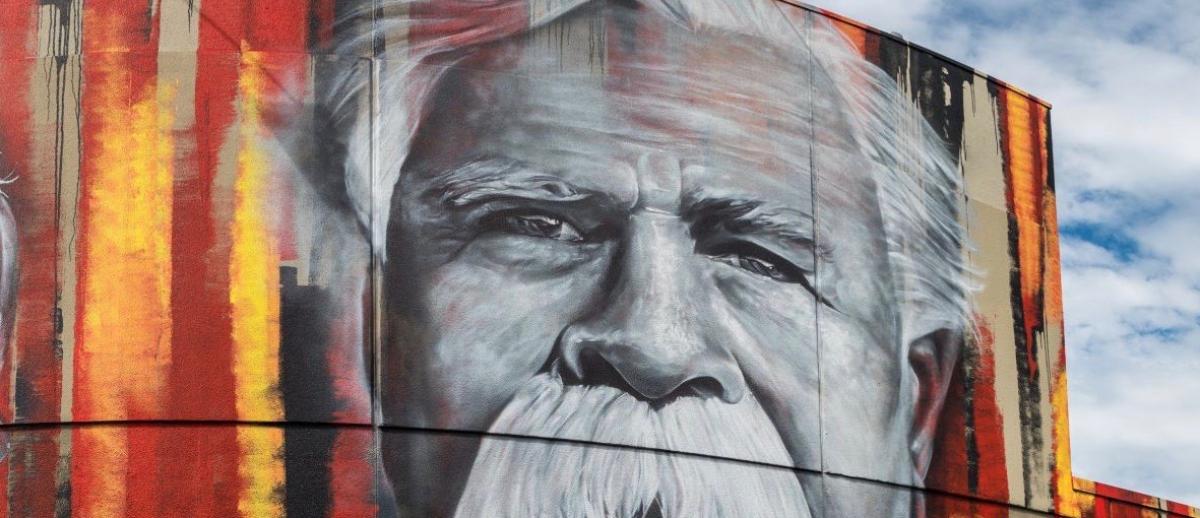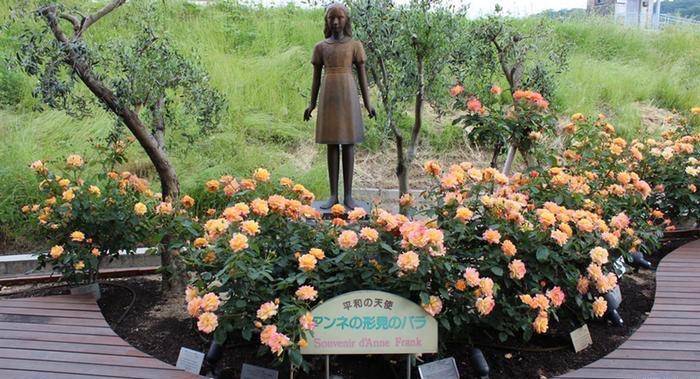Mnemonic Solidarity in the Global Memory Space
archive


mural depicting aboriginal leader and anti-Nazi protestor William Cooper, part of Greater Shepparton Aboriginal Street Art Project.
Mnemonic Solidarity in the Global Memory Space
Arguably, “the focus in the globalization discourse has shifted from imagination to memory” at the turn of the third millennium.1 The mnemoscape—the topography of social memory—was one of the domains of the human imagination reconfigured most dramatically by the spatial turn of globalization. Global memory space has emerged to challenge the nation-state as the legitimate container of collective memories. Freed from the nation, memories have become entangled, cohabitated, reconciled, contested, conflicted, and negotiated across borders. Due to the global movement and transaction of memories, unconnected historical actors and memory activists are linked mnemonically a posteriori in the global memory space, even though no de facto entangled history exists. It is not so much history that is entangled, but memory. In the emerging global memory space, memory activists have become agents of transnational solidarity across political and cultural boundaries. Whether mnemonic solidarity is possible and desirable or not remains an open question. However, it would be plausibly a new form of solidarity in the twenty-first century.
A meeting of Korean ‘comfort women’ victims and Holocaust survivors at the Queensborough Community College in New York City on 13 December 2011, co-organized by Korean American Civic Empowerment and the Kupferberg Holocaust Center, represents an example of globally entangled memory. The mnemonic confluence of Korean comfort women and European Jewish survivors was facilitated by the transatlantic and transpacific migration of memories to the USA. Holocaust and postcolonial memories have been entangled in the postwar era. The Australian Aboriginal League’s anti-Nazi protest action against the Kristallnacht of 1938, reenacted on 6 December 2012, exemplifies a parallel confluence of postcolonial and Holocaust memory in Australia. A series of controversial exhibitions of ‘Nazisme in Zuid-Afrika’ in the early 1970s, hosted by Anne Frank House in Amsterdam and organized by the ‘Anti-Apartheids Beweging Nederlands’, indicates the interaction of postcolonial and Holocaust memory, which was preceded by African-American communists’ petition to the UN for the recognition of American slavery as a genocide in 1951. In the USA, Holocaust resonances are even traced back to the fifteenth century in an outspoken comparison between Christoph Columbus and Heinrich Himmler by an American Indigenous Rights activist.2
Entangled memories of the Holocaust and colonial genocide tend to produce the extraterritoriality of remembrance by exposing national experience to a crisscrossing global accountability. It is characterized by the cosmopolitanization of the Holocaust, which transposes the memory of the Holocaust to contemporary sensibilities of genocide and ethnic cleansing in Kosovo, Rwanda, Sudan, and today’s Burma. However, the global memory space does not necessarily guarantee the de-nationalization of collective memories. Instead, the transnational history of victimhood nationalism invokes the re-territorialization of cosmopolitan memory within national boundaries; and as the Holocaust is used as a memory template of human tragedy, victimhood contestations over who suffered the most become more distasteful.3 Entangled memories globally intensify the contest over memory as well as the mnemonic solidarity among nations, nationalities, ethnicities, or races. Thus, global memory space fluctuates between de-territorialization and re-territorialization, mnemonic solidarity and contest.
The entangled memory of Auschwitz and Hiroshima/Nagasaki exemplifies the ambivalence of the global memory space. In a memorial mass for the A-bomb victims in Nagasaki on November 23, 1945, Takashi Nagai delivered a funeral message saying that the Urakami church, above which the bomb exploded, was "chosen not as a victim but as a pure lamb, to be slaughtered and burned on the altar of sacrifice to expiate the sins committed by humanity in the Second World War."4 It is interesting to note that Nagai picked out the word hansai (燔祭), the Japanese translation of ‘holocaust’ from chapter 22 of the Book of Genesis, to illustrate the sublime world-redemptive suffering of the Japanese hibakusha-A-bomb victims. Considering that the word ‘holocaust’ was not popular even in Israel and the ‘West’ until the late 1950s, Nagai’s speech is one of the earliest recorded public uses of ‘Holocaust’ in the postwar world. Nagai’s address of hansai premonished the connectivity of Auschwitz and Hiroshima/Nagasaki in postwar Japanese memory. Auschwitz and Hiroshima have been frequently cited as terrible twin symbols of human-made mass death and even singled out as two archetypical examples of White racism.5 In this simplistic juxtaposition, Holocaust as the decontextualized symbol of absolute evil served to territorialize memory by justifying national victimhood metonymically.
Freed from the nation, memories have become entangled, cohabitated, reconciled, contested, conflicted, and negotiated across borders.
The ‘Hiroshima-Auschwitz Peace March’ in 1962-63 embodies the intriguing interconnectedness of hibakusha victims and Holocaust victims by blaming American imperialism in alignment with Nazism.6 It explains why the Polish communist regime greeted those Japanese peace activists warmly, in contrast to the Japanese governing authority’s reluctance to support the Peace March. From a trans-Asian perspective, transposing the Holocaust onto Hiroshima and Nagasaki easily became a way of forgetting Nanjing, Bataan, comfort women, and other Japanese colonial atrocities. The obsessive Japanese attention to Anne Frank is another mark of nationalist appropriation of the Holocaust memory in the Pacific. As Alain Lewkovitz explains, “the Anne Frank-Japan connection is based on a kinship of victims” in Auschwitz and Hiroshima/Nagasaki. But the Japanese don’t think of the countless Anne Franks their troops perpetrated in Asia.7 Holocaust was instrumentalized to stress national victimhood metonymically in Eastern Europe too. Polish nationalists used the term ‘forgotten Holocaust’ and defined Poles as “the first people in Europe to experience the Holocaust.” German memories of the Allied bombing, Central & East European Vertriebene, and Ukrainian Holodomyr referred the Holocaust as the memory template.

Statue of Anne Frank at the Holocaust Education Center in Fukuyama City, southern Japan.
Reflection on this manner of connecting Auschwitz and other genocidal atrocities illuminates why any simple juxtaposition of genocidal tragedies cannot serve cosmopolitan memory. Mnemonic solidarity would demand a critical and radical juxtaposition of different, unrelated, yet entangled memories in the global memory space. It aims at “a non-hierarchical act of comparison” in order to “illuminate both commensurabilities and incommensurability” of human tragedies in different parts of the world.8 Otherwise, cosmopolitan memory is subject to the nationalist vulgarization and mnemonic solidarity is vulnerable to the struggle among antagonistic mnemonic hegemons. It is not difficult to witness mnemonic hegemons struggling behind the scene of the cosmopolitan memory. A capital letter ‘Cosmopolitan’ memory may sharpen antagonistic competition among different mnemonic hegemons. Mnemonic solidarity would be possible not by imposing the single capital letter ‘Cosmopolitan’ memory, but by attaining a conflictual consensus of competing memories.
Entangled memories of the Holocaust and colonial genocide tend to produce the extraterritoriality of remembrance by exposing national experience to a crisscrossing global accountability.
One more point. Mnemonic solidarity is not always positive. Deniers globally have been in search of mnemonic solidarities of their own. For instance, Holocaust denial has provided the referential idea for generic negationism, including the Jedwabne massacre in Poland, stolen Aboriginal children in Australia, comfort women during the Japanese empire, the Armenian genocide, and other colonial atrocities. The emergence of the global memory space elevated Holocaust denial to a universal negationism. The Holocaust denial conference in Teheran in December 2006 is a good example. David Duke’s keynote speech following Ahmadinejad’s opening speech connotes a strange alliance of the Islamic theocracy with the KKK’s white supremacism. Iranian efforts to delegitimize the state of Israel were connected with the KKK’s new policy to escape from the racist stereotype by allying with the colored Third World.9 Thus, looking awry at both the Holocaust and its denial as templates of cosmopolitan memory remains a challenging task.
_____________
Editor’s note: This global-e special issue series on “Mnemonic Solidarity in the Global Memory Space” was supported by the National Research Foundation of Korea Grant funded by the Korean Government (2017S1A6A3A01079727).
1. Aleida Assmann and Sebastian Conrad, “Introduction,’ in Aleida Assmann and Sebastian Conrad eds, Memory in a Global Age: Discourses, Practices, and Trajectories (Palgrave Macmillan, 2010), p. 1.
2. Shirli Gilbert. "Anne Frank in South Africa: Remembering the Holocaust During and After Apartheid." Holocaust and Genocide Studies 26, no. 3 (2012): 366-393. https://muse.jhu.edu/ (accessed March 10, 2018), pp. 374-5; Ann Curthoys and John Docker, “Defining Genocide," in Dan Stone, ed. The Historiography of Genocide (Basingstoke: Palgrave Macmillan, 2010), pp.16-21; Ward Churchill, “American Holocaust: Structure of Denial,” Socialism and Democracy, vol. 17, no. 1 (2003), p. 26.
3. See Jie-Hyun Lim, “Victimhood Nationalism in Contested Memories-Mourning Nations and Global Accountability” in Memory in a Global Age, pp. 138-162.
4. Konishi Tetsuro, “The Original Manuscript of Takashi Nagai’s Funeral Address at a Mass for the Victims of the Nagasaki Atomic Bomb,” The Journal of Nagasaki University of Foreign Studies, No. 18 (December, 2014), pp. 58, 61.
5. Ian Buruma, The Wages of Guilt: Memories of War in Germany and Japan Korean Translation (Seoul: Hangyŏreh Shinmusa, 2002), pp. 119-26; John W. Dower, ‘An Aptitude for Being Unloved: War and Memory in Japan’, in Omer Bartov et. al. eds., Crimes of War: Guilt and Denial in the Twentieth Century (New York: The New Press, 2002), p. 226; James J. Orr, The Victim as Hero: Ideologies of Peace and National Identity in Postwar Japan (Honolulu: University of Hawaii Press, 2001).
6. See Ran Zwigenberg, "Never Again: Hiroshima, Auschwitz and the Politics of Commemoration," The Asia-Pacific Journal, Vol. 13, Issue 3, No. 1, January 19, 2015.
7. https://www.haaretz.com/jewish/anne-frank-the-japanese-anime-1.5314070, last accessed on January 15, 2019.
8. Susan Stanford Friedman, “Planetarity: Musing Modernist Studies,” Modernism/Modernity, vol. 17, No. 3 (2010), p. 493.
9. George Michael, “Mahmoud Ahmadinejad’s Sponsorship of Holocaust Denial,” Totalitarian Movements and Political Religions, Vol. 8, (September–December, 2007), pp. 667–671.



